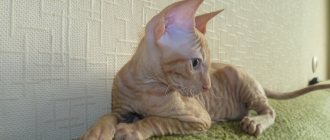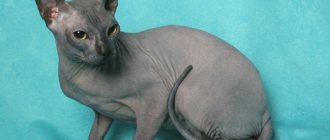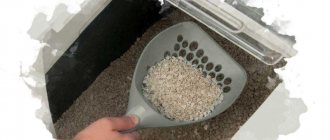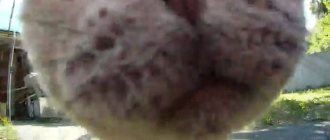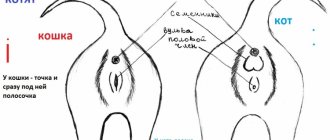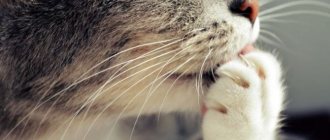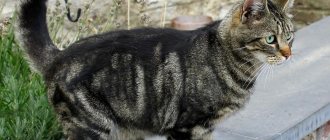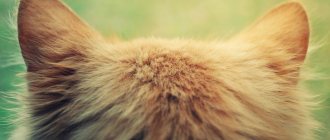In fact, cat fur is a hair coat that is a derivative of the epidermis. There are different types of fur: thin, thick, soft like down and hard like bristles, straight or curly. Despite such differences, it is important to care for long-haired and short-haired breeds regularly, otherwise the condition of the coat will worsen, in addition, the risk of developing various dermatological pathologies, which are not easy to deal with, will increase.
Types of hair in cats and description
Coat types, which are an individual feature of the breed, are classified based on the length, thickness and structure of the hairs.
In addition, the specific combination of guard hair, guard hair, and undercoat is determined. Based on this criterion, the following types of cat hair are distinguished:
- Undercoat. This is soft, fluffy fur, the main function of which is thermal insulation. It is the presence of undercoat on the body that provides the animal with reliable protection from the cold in winter and from the heat in summer. If you do not take care of the coat and comb it in a timely manner, this layer becomes tangled. The animal looks unkempt and sheds heavily. However, some breeds, such as Orientals, have no downy hair at all.
- Guard hair. Forms a middle covering layer. At the base the hair is thinner, and at the tip it thickens. The structure and size vary depending on the individual characteristics of the variety. One species has guard and guard hairs of the same length; in others, the guard may be shorter.
- Protective. It differs from other types in that it has a rigid structure that protects the animal’s body from getting wet. The hairs are wider from the base, but gradually narrow towards the tip. It is this type of cat fur that determines the main color.
- Pooh. Grows in kittens and sphinxes. The hairs are very thin, sparse, and difficult to distinguish in adult representatives.
- Vibrissae. They are long whisker hairs that take an important part in the life of the animal. Whiskers are located on both sides of the muzzle, above the eyes and on the outside of the lower leg. It is forbidden to cut off tactile hair, because without it the animal will not be able to fully receive signals from the outside world and fully communicate with its relatives.
Main types of cat fur
For a long time, cats were classified into two types based on the length of their fur:
- short-haired, with a coat length of up to 5 cm
- long-haired, with a coat length exceeding 5 cm
Today, breeders have expanded this range by breeding new and unique cat breeds. Thus, hairless representatives of cats appeared, which can be naked or have hair not exceeding 1 cm in length.
Hairless (hairless) cat breeds
Hairless types include several interesting species:
- flock - velvety hairs, so short that they are visually difficult to distinguish, but are noticeable when stroking the animal
- brush - actually bristles, hard, sparse and broken short hairs
- velor – curly soft hairs, visually distinguishable on the animal’s body
Some breeds of hairless cats are born almost completely naked, sometimes with sparse hair on the face, paws and tail. Others are born with sparse hair, which, as a rule, falls out completely or partially before the animal is 1.5 years old.
Short-, semi- and long-haired cats
In addition to hairless breeds, modern felinologists have identified the category of semi-long-haired cats, which includes animals with a coat length of 5-10 cm. As for real long-haired breeds, these are cats with luxurious hair over 10 cm in length.
Cat fur can be:
- long
- double (guard hair and undercoat of the same length)
- semi-long with and without undercoat
- short with undercoat and without undercoat
- rigid or wire
- curly or wavy (rex)
The cat's coat performs the function of thermoregulation, protecting the animal's body from the negative effects of the environment. Closer to summer, cats shed their undercoat - they shed. The fur coat becomes lighter, which means the animal can more easily tolerate high air temperatures. In autumn the reverse process occurs. Cats grow an undercoat and pets become very fluffy. And such a fur coat is practically not afraid of cold weather. What are the features of caring for different types of cat fur?
Features of caring for hairless cats
Hairless cats require special care. Devoid of hair, these animals have very delicate skin. Unlike their furry relatives, they need more frequent water treatments. For this purpose, special cosmetics are used. For example, hypoallergenic shampoo for hairless cat breeds. To prevent dry skin, it is lubricated with a special moisturizer, light oil or high-quality baby cream, preferably hypoallergenic. In the summer, hairless cats are bathed at least once a week, and in other seasons - at least once a month. If the pet does not like water treatments, gently wipe the skin with a damp sponge. By the way, some breeders recommend wiping the body of hairless cats daily with a soft cloth soaked in warm water.
Features of caring for short-haired cats
The fur of short-haired cats has a length of no more than 5 cm. The group of short-haired breeds includes a lot of cats - Burmese, Singaporean, Bombay, Abyssinian, Bengal. However, the structure of their fur may be different. For example, the Russian Blue has a double coat that is thick and silky, while the Siamese and Oriental have a smooth coat that lies close to the body.
Short-haired felines require the least amount of grooming. To keep the coat healthy, beautiful and shiny, 1-2 brushing procedures per week are enough. Massage brushes for cats with short hair are ideal for this. During the shedding period, the number of procedures for combing the undercoat can be increased to 3-4 times a week, and the Furminator Grooming Rake brush can be chosen as an effective tool.
Bathe animals as they become dirty, using shampoos for cats with short hair.
Caring for semi-longhaired cats
Semi-longhaired cats have a coat length of 5-10 cm. Breeds with this type of coat include, for example, Burmese cats and Maine Coons. Typically, in winter and summer, these animals have a difference in the length of their fur.
Caring for semi-longhaired cats requires a lot of time, especially during the molting period. As a rule, the combing procedure is carried out 3-4 times a week, and during molting - daily. To comb out the undercoat, use a special brush - a slicker brush. To comb long guard hairs, use a brush or comb. If tangles have formed, you cannot do without a tangle cutter for cats.
Cosmetics for bathing semi-longhaired cats are selected with special care. In addition to shampoo that matches your coat type, you will need conditioner or balm. They will make the combing process easier and make the coat beautiful and shiny.
Caring for long-haired cats
Many people prefer long-haired cats, such as the Neva Masquerade, Persian or Himalayan. These are truly incredibly beautiful animals, but with only one “BUT”. The beauty of wool depends on the correctness, thoroughness and timeliness of caring for it, especially during the molting period. This requires a lot of time, knowledge and patience.
Caring for long-haired cats is virtually no different from caring for semi-long-haired cats. True, they are combed almost daily, regardless of the molting period. Cosmetics for long-haired cats include many products aimed at preventing tangling of the hair and unraveling the resulting tangles. Combs, brushes and other grooming tools must be selected taking into account the length of the animal’s fur.
Even the most common types of cat fur require proper, timely and high-quality care. Do not forget that the appearance of the coat is affected not only by care, but also by nutrition. If any problems arise with the animal’s fur, it begins to fade, falls out in clumps or constantly sheds – this is a reason to contact a veterinarian.
How is color formed?
The main component of all cat colors is two basic colors: orange and black.
There are 2 main basic cat colors:
- black;
- orange or red.
It is these colors that are the main component of the various shades. Most colors are characteristic of purebred and outbred felines. However, breeders, during complex selective work, were able to ensure that only a certain variety could have a certain color, for example, pure white.
Fur length
The following types of breeds are distinguished depending on the length of the hair:
- Naked. This variety was not specially bred, and the main reason for the lack of hair is a gene mutation. If both parents are bald, the kittens that are born will also have no hair. However, there is still a small amount of fine hairs on the skin that are not able to protect the animal from the cold.
- Short-haired. This species has fur that does not exceed 5 cm in size. Despite the fact that the hair is thick, it does not require special care. It is enough to scratch the animal 1-2 times a week with a special brush to get rid of lost hairs.
- Semi-longhaired. The variety has long hair, but the undercoat is not very thick and fluffy. The difference in fur length is most noticeable in winter and summer.
- Long-haired. This beautiful fluffy breed's fur grows no less than 10-12 cm. The animal requires special, careful care so that the fur coat shines, does not become disheveled and does not become covered with tangles. In addition, animals are prone to heavy shedding, which increases the risk of hair accumulation in the digestive organs.
When do kittens change fur and eye color?
Changing eye color
For a newborn kitten, vision does not play a significant role. Babies open their eyes between one week and 16 days. Only in the third week of life do they begin to see. Until four weeks of age, a kitten's eyes are covered with a protective film; it disappears on its own when the time comes. Small kittens usually have blue or blue-gray eyes. This is due to the fact that almost all the pigments went to forming the fur color; they have not yet really reached the eyes. In one month, when the kittens' eye color changes, it becomes noticeable that splashes of a different color have appeared in the sky-blue iris.
The less pigment, the lighter and cooler the eye shade. At the time of birth, there is still very little pigment in the iris. For this reason, all babies have cool blue or light blue eyes.
The process of changing the color of a kitten's eyes is called pre-blooming. If you want a pet with a certain eye color, choose a baby around four months old. By this point, the kitten’s eye color has changed so much that one can conclude what it will be like throughout its life. With a 50% chance you can guess what your pet's eyes will be like by looking at the eye color of its parents. Some changes in eye color are possible before the age of two. Green eye color takes longer to form than others.
You should not think that the color of a kitten's eyes is related to its color. They are directly related only in purebred cats - breeders have fixed a certain trait through selection. The main eye colors in cats are green, gold, copper, blue, blue. There are some restrictions on eye color related to belonging to a particular breed. Representatives of the Russian Blue breed have green eyes of varying color saturation. An adult Siamese cat has blue or blue eyes - here the eye color undergoes minimal changes from an early age. Ojos Azules cats have blue eyes. Ojos azules is translated from Spanish as blue eyes. These are just some examples.
There are albinos among cats. They have white fur, but their eyes can be different colors, such as blue or green.
Another feature of eye color is heterochromia, that is, one eye is different in color from the other due to the uneven distribution of pigment. Heterochromia is uncommon in cats and does not affect vitality or vision.
Changes in color
Kittens are born with fur. Babies' coats actively develop and change noticeably in texture and color in the first year of life. Kittens exchange their baby downy coat for a guard coat; already at the age of one week, the fur begins to fluff up, and the first undercoat can be seen. At five weeks, the kitten’s fur pattern becomes brighter and more contrasting, and the undercoat becomes denser. White little kittens often have a colored spot on their head, which later disappears. Felinologists advise starting to accustom your kitten to brushing as early as two and a half months. The pet still has little hair that needs to be combed. But this is the right moment to make the procedure something familiar to the kitten, a ritual of communication, and not a severe necessity.
At the age of three months, kittens have already formed a fur pattern. But it will be possible to determine the color of the kittens a little later - at six to seven months, the felinologist will be able to tell you what the pet’s color will be throughout its life. The head and ears are the main indicator; on the body the color will vary a little longer.
When a growing kitten is five months old, the color begins to change. At five to eight months, your furry friend will experience her first molt. Consult with your veterinarian which vitamins are best to give to your pet during this difficult period. Be sure to brush your pet so that he doesn't eat his own fur. By 10 months the color will be fully formed. A little later, around his first birthday, your pet will stop growing. However, up to two and a half years old, the cat is still very young, he continues to grow stronger and accumulate strength for a long, happy life.
Law of nature
When kittens change eye color, we are talking about the natural development of the pet. But a change in eye color in an adult cat indicates a possible injury or illness. Eye color may change when exposed to medications. Your pet's eyes and fur will tell you a lot about his well-being and will give an alarming signal about the need to visit a veterinarian.
The color of adult cats may change in an unsightly way due to prolonged exposure to the sun. A black cat may become partially red from too much sunbathing and its fur will fade. Diet can affect color. Sometimes changing food turns into an unpleasant surprise - dyes from the food migrate to the cat’s fur. Some vegetables can also affect color. If the change in color is accompanied by lethargy, loss of appetite and other alarming symptoms, your cat should be shown to a specialist. In this way, nature helps us better understand our pets and be sensitive to their health.
Difference from hair
All mammals, including humans, have hair on their bodies, the number and structure of which depends on their functional purpose.
The hair of animals has the ability to provide thermal insulation, which distinguishes it from humans.
When thick, thick hair grows all over the body, it is called fur. In cats, hair is called fur. Any type of hair, regardless of structure and other characteristics, grows from a follicle. In different areas, the hairs differ in structure and density. The main difference between human hair and animal hair is that the latter’s core of the hair follicle has the peculiarity of providing reliable thermal insulation. In humans, the composition of hair has the same structure, but in animals, hair consists of guard and integumentary hairs.
Features of fluffy cat breeds
The basis of their “image” is, of course, wool. Fluffy cats of long-haired breeds have long, thick hair, which sometimes reaches more than five centimeters in length. It consists of hairs of different lengths: the short, softest and thinnest hairs form the undercoat, and the longest, thickest and harshest hairs form the upper integumentary layer. The long, thick coat protects the undercoat and guard hairs from damage, and the skin from getting wet. The undercoat is located close to the skin, helping to maintain normal body temperature. Without regular combing, it can become matted, forming a dense, felt-like cover.
Photos of fluffy kittens
What building?
Hair consists of 2 parts: the hair follicle, located under the skin, and the shaft. In addition, each hair consists of 3 layers:
- Cuticle. Layered on top of each other, tightly connected keratin scales that form the top layer of hair. Dry and dull hair on a cat is a consequence of damage and separation of scales.
- Cortex. It is a cortical layer consisting of dead cells. In addition, the cortex contains a pigment that determines the main color of the animal.
- Brain matter. Provides nutrition to the cuticle and cortex.
Diseases of the coat
Causes and symptoms
If a cat’s fur coat has stopped shining and is getting into clumps, then there is a possibility of developing a disease in its body.
If the care of the cat’s fur is correct, the animal is healthy, then the fur coat is smooth, thick, and shiny. If not properly maintained, the hair can become tousled, tangled, and unattractive. Various diseases also affect the appearance of a fur coat, among which the following are common in cats:
- hormonal disorders;
- allergy;
- helminthiasis;
- fungal skin diseases;
- congenital disorders;
- weakened immunity;
- viral or bacterial infection;
- dysfunction of the sebaceous glands;
- liver diseases, in which, in addition to deterioration in the quality of the coat, the mucous membrane becomes yellow.
Other reasons:
- pregnancy;
- molt season;
- uncontrolled use of certain groups of drugs;
- stress;
- elderly age.
Symptoms of wool disease are:
Symptoms such as dandruff and itching indicate problems with the coat.
- Tarnishing and profuse hair loss.
- The hairs are constantly whipped into dense tangles and hang in icicles.
- Dandruff and inflammation appear on the skin on the right and left sides.
- Worried about itching, redness.
- Body temperature rises.
- The animal becomes lethargic and drowsy.
Body type
Depending on how the cat is built, breeds can be divided into two types:
- Animals with a large and rounded head, a flattened nose and a stocky body. Most often, Persians and exotics have these parameters;
- The wedge-shaped head, elongated muzzle, body and paws are a set of features inherent in Angora, Oriental Shorthair and Siamese cats.
What to do to restore hair?
If a cat has bad fur, it is first important to find out the reasons for the deterioration of its condition. To do this, you need to show your pet to a veterinarian and provide a detailed description of the cat’s condition. After the initial examination, the doctor will give a referral for a comprehensive diagnostic examination. Once the diagnosis is made, treatment is prescribed.
In addition to using the medication prescribed by your doctor, it is important to review your pet’s diet and add vitamins and nutrients to it. Proper care of a cat's fur is also important. The animal must be bathed periodically with special means. It is useful to comb 1-2 times a week, and if shedding occurs, it is recommended to comb the coat more thoroughly and repeat the procedure daily.
A little about molting
All cats with fur experience natural hair loss. This process occurs much more intensely in long-haired breeds and in animals with voluminous undercoat.
Since the fluff in the lower layer has a finer structure, changing this hair brings more inconvenience to the owners - weightless pieces of fur fly throughout the house, settling on clothes and furniture, getting into the eyes and getting into the respiratory tract.
It is not so difficult to survive seasonal shedding; it occurs twice a year - at the beginning of spring and autumn, when the undercoat changes.
But domestic cats that do not walk outside often experience the effect of “indoor” shedding. The cat is constantly warm and shedding its undercoat occurs almost constantly.
Also read what to do if your cat is constantly shedding.
